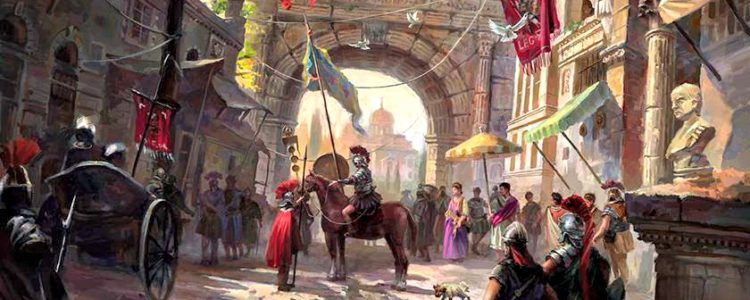The design and width of Roman roads was specified by the Laws of the Twelve Tables around 450 B.C. Major thoroughfares designed for side by side carts were known as viae. They were to be 8-feet wide on the straightaway, and twice that width on curves. Ideally they were built as straight and narrow as possible, thus reducing the amount of materials needed. Notable were the Via Sacra and Via Nova, which crossed and flanked the Forum.
Public streets designed to accommodate single carts were known as actus (path or tract). These narrow, 4-foot wide roads led to terrible traffic problems in downtown Rome. Urban actus streets would bend and twist around the insulaes and buildings; pedestrians and delivery carts clogged the roads causing exasperating traffic jams. Although they were not intended to be one-way, practically speaking, they were. In order to pass through, wagon and chariot drivers were forced to send runners down the road to hold up traffic.
The paralyzing congestion led to the Lex Iulia Municipalis laws of 45 B.C. With the exception of certain government activities, daylight traffic was restricted to pedestrian mode only. All carts, wagons, carriages, chariots, horses and livestock were banned from within 1-mile of urban areas until 2-hours before sunset. Hauling of merchandise and building materials, along with personal transport by carriage and horseback, could only occur after dark. Consequently, any hopes of peaceful slumber was overcome by the sound of creaking wagons, cursing drivers, noisy animals, and racket from deliveries. Whether by night or day, city traffic was a very unpleasant experience.
The dangers of the crowded city streets were recorded by Juvenal: “Even though we might try to hurry, the surging crowd blocks our progress, and the dense mob crushes against us from behind. In the press, one man shoved me with his elbow, another sticks me with a pole, a third smacks a board over my head, and yet another cracks his wine jar up again my forehead. My legs become encrusted with stinking mud, from all sides big feet trample on me, and a passing soldier grinds my toes under the hobnails of his boots.” (Juvenal, Satires 3.244-48, A.D. 110)
Interesting to note that the maintenance of city streets fell under the general jurisdiction of the property owners. One legal text states that “each person is to keep the public street outside his own house in repair and to clean out the open gutters. They are not to throw excrement, dead animals, or skins into the street” (Digest of Roman Law 43.11.1.1). However, the final responsibility for the proper maintenance lay with the official government aedile. Caligula once thought the streets were neglected, and as punishment, had his soldiers fill the adile’s toga with road mud.
All Rights Reserved
Excerpt from Ancient Minutus
